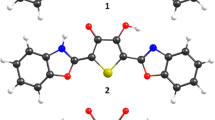Abstract
Electronic and steric effects of the substituent on the 2-position of the heterocyclic ring of various 2-substituted 2,3-dihydroquinazolin-4(1H)-ones (DHQZ) were studied using voltammetric methods at a glassy carbon electrode in chloroform. Analysis of the results indicates that the electronic nature and the steric hindrance of the 2-substitution determine the effects on the oxidation peak potentials. The nature of the solvent also affects the electron detachment process in this study, which explains the extent of solvation of both the neutral DHQZ molecule and the ionic DHQZ·+ intermediate. Analysis of the computational results obtained at the density functional level of theory-B3LYP/6-31++G** level of theory suggests a mechanism in which the first electron removal occurs preferably from the N1 atom of both possible donor positions, N1 and N3 atoms. This process is followed by a fast proton removal from the 2-position of the heterocyclic ring, resulting in the formation of stable benzylic and also donor substituted radicals, which then undergo further oxidation to the quinazolin-4(3H)-ones. Computational studies in the gas phase and also in the bulk of solvent explain the effect of the nature of solvent on the readiness of the electron detachment process.
Graphical abstract





Similar content being viewed by others
References
Patel NB, Pael JC (2011) Med Chem Res 20:511
Amnerkar ND, Bhusari KPD (2010) Eur J Med Chem 45:149
Kamal A, Bharathi EV, Reddy JS, Ramaiah MJ, Dastagiri D, Reddy MK, Viswanath A, Reddy TL, Shaik TB, Pushpavalli SNCVL, Bhadra MP (2011) Eur J Med Chem 46:691
Wu H, Xie XL, Liu G (2010) J Comb Chem 12:346
Farghaly AM, Soliman R, Khalil MA, Bekhit AA, el-Din A, Bekhit A (2002) Bull Chem Farm 141:372
Bakavoli M, Sabzevari O, Rahimizadeh M (2007) Chin Chem Lett 18:1466
Davoodnia A, Allameh S, Fakhari AR, Tavakoli-Hoseini N (2010) Chin Chem Lett 21:550
Cabrera-Rivera FA, Ortíz-Nava C, Escalante J, Hernández-Pérez JM, Hô M (2012) Synlett 23:1057
Memarian HR, Soleymani M, Sabzyan H, Bagherzadeh M, Ahmadi H (2011) J Phys Chem A 115:8264
Memarian HR, Ranjbar M, Sabzyan H, Kiani A (2012) C R Chim 15:1001
Memarian HR, Ebrahimi S (2013) J Photochem Photobiol A Chem 271:8
Abdollahi-Alibeik M, Shabani E (2011) Chin Chem Lett 22:1163
Hyperchem Release 7.0, Windows Molecular Modeling system, Hypercube, Inc. http://www.hyper.com
Frisch MJ, Trucks GW, Schlegel HB, Scuseria GE, Robb MA, Cheeseman JR, Zakrzewski VG, Montgomery JA, Stratmann RE, Burant JC, Dapprich S, Millam JM, Daniels AD, Kudin KN, Strain MC, Farkas O, Tomasi J, Barone V, Cossi M, Cammi R, Mennucci B, Pomelli C, Adamo C, Clifford S, Ochterski J, Petersson GA, Ayala PY, Cui Q, Morokuma K, Malick DK, Rabuck AD, Raghavachari K, Foresman JB, Ciolowski J, Ortiz JV, Stefanov BB, Liu G, Liashenko A, Piskorz P, Komaromi I, Gomperts R, Martin RL, Fox DJ, Keith T, Al-Laham MA, Peng CY, Nanayakkara A, Gonzalez C, Challacombe M, Gill PMW, Johnson B, Chen W, Wong MW, Andres JL, Head-Gordon M, Replogle ES, Pople JA (1998) Gaussian 98. Gaussian Inc, Pittsburgh
Reed AE, Weinstock RB, Weinhold F (1985) J Chem Phys 83:735
Carpenter JE, Weinhold F (1988) J Mol Struct (Theochem) 169:41
Reed AE, Curtiss LA, Weinhold F (1988) Chem Rev 88:899
Xiao-Hong L, Zheng-Xin T, Xian-Zhou Z (2009) J Mol Struct (Theochem) 900:50
Acknowledgments
We are thankful to the Research Council and Office of Graduate Studies of the University of Isfahan for their financial support, and to Prof. R. Karimi and Dr. A. Kiani for helpful discussion.
Author information
Authors and Affiliations
Corresponding author
Additional information
In memory of Prof. M. Rahimizadeh, University of Ferdowsi, who passed away on 24 March 2014.
Rights and permissions
About this article
Cite this article
Memarian, H.R., Ebrahimi, S. Theoretical and voltammetric studies on the electron detachment process of 2,3-dihydroquinazolin-4(1H)-ones. Monatsh Chem 145, 1545–1554 (2014). https://doi.org/10.1007/s00706-014-1221-x
Received:
Accepted:
Published:
Issue Date:
DOI: https://doi.org/10.1007/s00706-014-1221-x



